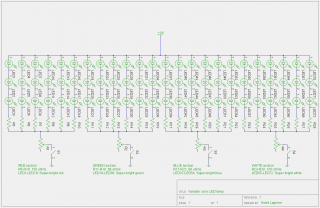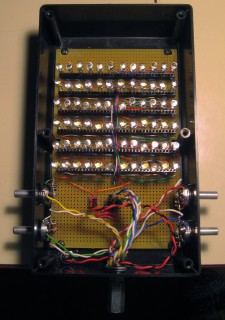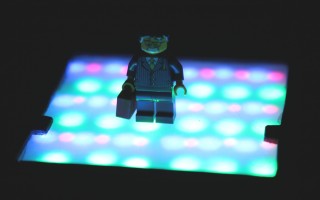What I’ve Been Watching
Latest batch of movies I’ve seen:
The Girl with the Dragon Tattoo (2011) – Not my usual type of movie, but it was pretty good. A pretty typical Mundane detective thriller – and I admit I didn’t anticipate who turned out to be the bad guy. The only part that was worth seeing on the big screen was the (awesome) opening credits – the rest, while competently filmed, didn’t have any eye candy.
The Adventures of Tintin – I wrote a separate post about this one here.
Cry Baby Lane – This one attracted my attention because I heard it was made by Nickelodeon (unusual for them to make a thriller) and was not aired because it was deemed to scary for the intended audience at the time. I’m not sure I agree – it’s pretty tame by today’s standards.
Battle Los Angeles – I swear I’ve seen this movie before. A bunch of alien retards with superior tech launch a freaking ground war against Earth to steal resources they could much more easily obtain out in space. Humans lose ground until a small group of jarheads get unreasonably lucky and find the invaders’ critical weakness (in this case, a stupidly centralized resource again). The only thing this movie has going for it is the animation on the alien aircraft – I love their hover mode propulsion method.
Darkness (2002) – Surprisingly one of the better horror movies made in the last couple of decades, in my opinion. Unpredictable. Fairly standard genre story, but well executed. I especially liked the ending.
One Week (2008a) – Recommended to me in a conversation about my recent cross-Canada road trip, and very appropriate. Lots of scenery and stretches of road I’ve seen in this film – the story perhaps didn’t have the intended impact on me because I was too busy letting it lead my reflection on my own journey to concentrate on the character’s journey.
Sharktopus – Poster child for the current trend of the B-monster-movie genre self-parodying. It’s the usual thing: Misguided scienticians create a monster that runs amok for a while until they kill it. Only this one is tongue-in-cheek.
Stonehenge Apocalypse – Contains everything bad about prophesy-driven disaster movies, though it does go further with the actual disasters than most. Very skippable.
The Thing (2011) – I dunno. It didn’t have anywhere near the impact on me that the Kurt Russell one did. Maybe I’m just too desensitized now. This one is a prequel and does seem to fit well in that role, though it’s been too long since I saw the two originals that I can’t be sure it meshes cleanly.
The Tunnel (2011) – Above average as modern monster/suspense movies go, though still not great. This one did appeal to the urban exploration nerd in me.
The Hole (2009) – I really liked the concept of this one. The execution was competent but unremarkable.
Killer Tomatoes Strike Back and Killer Tomatoes Eat France – I’ve long been a fan of the original Attack of the Killer Tomatoes, and was somewhat disappointed with the sequel, Return of the Killer Tomatoes. The first movie didn’t really need a sequel. I only recently discovered these two additional sequels, and they’re not needed either. The three sequels (plus TV series!) smell like a poorly executed attempt to build the original film’s cult following into something with enough inertia to become a money-making merchandising property. Each sequel is even more self-conscious and over the top, with the final one making extensive use of the fourth wall. The only saving grace the sequels have is the villain, Dr. Gangreen, and his henchman Igor – they’re actually somewhat amusing, and Gangreen is a respectable evil mad scientist – too bad he’s trapped in these turkeys.
Tetsuo the Bullet Man – OMG this was dumb. The usual Guyver genre crap, plus weird-ass ideas about genetics, largely incomprehensible characters and really bad cinematography, and a climax that felt like a bad ripoff of Tetsuo’s situation from Akira. Waste of time.
Psycho (1960), Psycho II, Psycho III, Psycho IV and Psycho (1998) – The first movie has been on my to-watch list for ages, and upon discovery of the sequels and the remake I finally got around to it. Watched them all in the space of a week. Despite its firmly entrenched place in pop culture, the first one surprised me with how much I didn’t know about it – for example I thought the famous shower scene was near the end, but it’s actually at the halfway point. I quite enjoyed it.
The three sequels actually do a pretty decent job of maintaining continuity with the first movie, though they unavoidably get increasingly contrived. Psycho II in particular was a pretty well done sequel that actually made sense relative to the events of the first movie. Psycho IV is missing half its ending in my opinion – given the way the story is structured, it needs two resolutions for the two sets of principal characters, but it only has one – leaving the first group of characters we met hanging in a suspenseful limbo.
The 1998 remake was a bit of a train wreck. It’s a scene-for-scene, word-for-word remake of the original movie, with just a couple of (completely unnecessary) embellishments. That by itself wouldn’t necessarily be a bad thing. The problem is that it’s full of anachronisms. The scene-setting text at the opening says the story is set in 1998, but using the dialogue from the original script makes the characters act like 1960s throwbacks. Most of the cars are modern, but the clothing is 1960s style. In the scene where the Sheriff’s wife phones the hotel, she still asks the switchboard operator, by name, to connect her – in 1998! Very confusing. This would have been better if they had either preserved the 1960 setting with all its trappings, or fully updated it to the 1990s, including rewriting the dialogue appropriately.
Edit: I meant to add that Anne Heche was incredibly cute as Marion Crane in the remake. My new mental image of the term “elfin beauty”.
A thing I have finished
I’ve been craving a feeling of accomplishment for a long time, and I promise myself that over the Christmas holidays I would make an effort to finish at least one of my personal projects. And I did! And it feels good.
For a while I’ve been needing some bright lights for my macro photography, and also wanting some bright color accent lights. I bought this from ThinkGeek. It has the advantage of simply plugging into a standard light socket, and has sixteen different color settings. I found it still a bit too dim, and some of the colors were off – blue especially looked too purple for me.
So I decided to make my own – a larger one using multiple super-bright LEDs of four colors (red, green, blue and white) arranged in a mosaic with a diffusing filter in front to mix the colors. With this arrangement I should be able to get a much better variety of colors, and using multiple LEDs would give me more brightness.
I based the physical design around available enclosures, protoboards and power supplies. I don’t like working with high voltages (they tend to be a bit killey) so I’ll always use an off-the-shelf power supply if I can. I decided on a 12V, 1A supply I had on hand because using a higher voltage would let me place the LEDs more in series, thus reducing the current requirements and the number of current limiting resistors I would need. Most super-bright LEDs have voltage drops between 3V and 4V, so that let me put them in series of three.
Here’s the schematic (click to embiggen):
I decided to socket the LEDs in female header strips instead of soldering them to the protoboard, in case I burnt some of them out and needed to replace them. In practice this perhaps wasn’t such a good idea; it complicated the physical layout of the circuit on the protoboard, and generated problems with loose connections between the LED leads and the sockets. I could probably solve the latter problem well enough by bending the ends of the leads slightly, but it seems to work well enough if I don’t shake it too much, and it’s easy to fix if a connection fails.
Here’s a picture of the finished board, populated with LEDs, installed in the enclosure I picked for it.
You can see the four brightness control potentiometers installed on the sides. At the bottom is a cheap tripod mount I made with a quarter-inch bolt and bolt joiner.
The next picture shows the reflective, scattering backdrop I put the LEDs through to help blend the colors. Since I was planning to put a diffuser in front of the LEDs, I figured there would be a lot of light back-scattered and so I should put a reflector at the back to stop some of the light from being wasted.
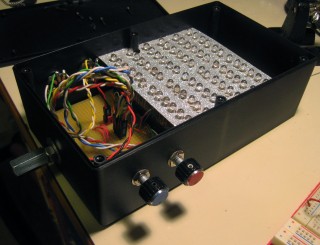 I also added the color-coded knob handles to the controls in this shot.
I also added the color-coded knob handles to the controls in this shot.
And finally, here it is with the diffuser on the front:
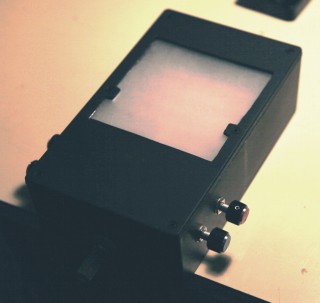 I made the diffuser myself by cutting a thin sheet of clear Perspex to size, then grinding both sides with coarse and then smooth sandpaper. It worked out well.
I made the diffuser myself by cutting a thin sheet of clear Perspex to size, then grinding both sides with coarse and then smooth sandpaper. It worked out well.
Although I had intended the light to be mounted vertically on top of a tripod or light stand, someone pointed out to me at this point that it could also be used horizontally as a small light table. It kind of looks like a disco floor when used this way:
And now, the results! To see if my project achieved its goals of brighter light and better color than the light I bought from ThinkGeek, I shot the following series of images (click to enlarge please). All images were shot using the same exposure and a fixed color temperature of 5400K. The upper row shows the primary colors of the ThinkGeek light, and the lower row is mine. Mine has an extra photo for white – the dim one is just the white LEDs, and the bright one is with all LEDs on at full intensity.
Conclusions:
- Mine is not as much brighter as I had hoped (perhaps half a stop for individual colors) but it is still brighter. The full-on white is considerably brighter.
- Mine has a slightly more bluish blue.
- The diffuser/reflector arrangement worked out well; when used as subject lighting rather than as a light table, the color mixture is very smooth. I could get more brightness by using a clear front panel instead of a diffuser, but then the colors would be less evenly mixed.
- Mine consumes slightly more power (9W versus their 7W) but that’s not a huge difference.
- Mine can produce a much wider variety of colors by virtue of having separate analog brightness controls for each of the four color components.
- Mine produces softer shadows on small objects because the light-emitting surface is relatively large; the ThinkGeek light is almost a point source so gives hard shadows.
